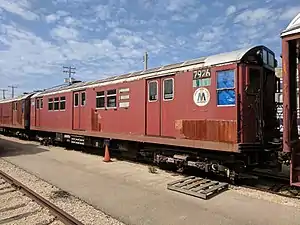R28 (New York City Subway car)
The R28 was a New York City Subway car model built by American Car and Foundry (ACF) from 1960 to 1961.[1] The cars were a "follow-up" or supplemental stock for the A Division's R26s and closely resemble them. The average car cost per R28 was $114,495.[2] A total of 100 cars were built, arranged in married pairs.
| R28 | |
|---|---|
 R28s 7926 and 7927 on display at the Illinois Railway Museum | |
| In service | 1960–2002 |
| Manufacturer | American Car and Foundry |
| Family name | Redbirds |
| Replaced |
|
| Constructed | 1960–1961 |
| Scrapped | 2001–2003 |
| Number built | 100 |
| Number preserved | 4 |
| Number scrapped | 96 |
| Formation | Semi-Married Pairs |
| Fleet numbers | 7860–7959 |
| Capacity | 44 |
| Operator(s) | New York City Subway |
| Specifications | |
| Car body construction | LAHT carbon steel |
| Car length | 51.04 feet (15.56 m) |
| Width | 8.75 feet (2,667 mm) |
| Height | 11.86 feet (3,615 mm) |
| Doors | 6 sets of 50 inch wide side doors per car |
| Maximum speed | 55 mph (89 km/h) |
| Weight | 70,000 lb (32,000 kg) (post-rebuild) |
| Traction system | General Electric 17KG192 (7860–7909 formerly Westinghouse) |
| Traction motors | Westinghouse (WH) 1447J/JR, General Electric (GE) 1257F1 |
| Power output | 115 hp (85.8 kW) |
| Electric system(s) | 600 V DC Third rail |
| Current collection method | Contact shoe |
| Braking system(s) | WABCO, "SMEE" (electrodynamic) |
| Coupling system | Westinghouse H2C |
| Track gauge | 4 ft 8 1⁄2 in (1,435 mm) standard gauge |
The R28s entered service on October 12, 1959, and received air conditioning by 1982. The fleet was rebuilt by Morrison–Knudsen between 1985 and 1987. The R28s were replaced in the early 2000s with the delivery of the R142 and R142A cars, with the last train running in October 2002. After being retired, most R28s were sunk into the ocean as artificial reefs, but several cars have survived.
Description
The R28s were numbered 7860–7959. They were the last passenger cars built by ACF, with the closure of the Berwick assembly plant following the delivery of the final cars delivered in January 1961.[3] ACF has since focused solely on freight rolling stock.
The first set of R28/R26s was placed in service on the 6 train on October 12, 1959. By 1982, all cars in this series had received air conditioning as part of a retrofitting program. Rebuilt by Morrison–Knudsen in Hornell, New York between 1985 and 1987, the R28s were repainted as Redbirds and were the first cars to be repainted in the scheme. They re-entered service, particularly on the 2 and 5 trains.
Retirement
As time wore on, heavy service took their toll on these cars. The R142 and R142A car orders replaced the entire R28 fleet. They were gradually phased out from May 2001, until the last two pairs 7862–7863, and 7938–7939, along with the last of the R26s made their final trip on the 5 on October 7, 2002.[4]
After retirement, all but two pairs were stripped to help create the Redbird Reef.[1] The two pairs that were not scrapped are preserved:
- Cars 7924–7925 are still on the New York City Subway property; this pair was previously used for work service at the Unionport Yard until July 2013, when they were moved to the Concourse Yard for storage, along with R26s 7774–7775 and R29s 8678–8679.
- Cars 7926–7927 are preserved by the Illinois Railway Museum. They were modified with trolley poles and are sometimes operated on the museum's electrified mainline.
Route assignment history
Note: All cars became General Electric (GE) cars and became permanently paired with link bars after rebuilding.
| Service | Years In Service | Cars |
|---|---|---|
| 6 | (1960–1966) | All cars[1] |
| 2, 4, 5 | 1966–1976 | General Electric (GE) cars[1] |
| 2, 5 | 1976–1985 | General Electric (GE) cars[1] |
| 6 | 1966–1985 | Westinghouse (WH) cars[1] |
| 7 | 1978–1985 | Some General Electric (GE) and Westinghouse (WH) cars as a temporary replacement for cars being sent out for air conditioning, overhaul and rebuilding[1] |
| 2/5 | 1985–2002 | All cars after overhaul and rebuilding[1] |
See also
- R26 (New York City Subway car) - a base model also built by American Car & Foundry Company.
References
- George Chiasson, Jr. "A Historic Perspective of the R-26, R-28, and R-29". New York City Subway Resources. Retrieved December 24, 2010.
- "IRT SMEE delivery dates", R36 Preservation, Inc. http://www.coronayard.com/r36preservation/irtsmeedelivery.html
- https://erausa.org/pdf/bulletin/2002/2002-11-bulletin.pdf
 Media related to R28 (New York City Subway car) at Wikimedia Commons
Media related to R28 (New York City Subway car) at Wikimedia Commons